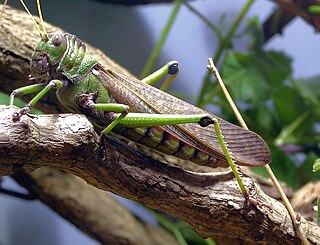
The Romaleidae or lubber grasshoppers are a family of grasshoppers, based on the type genus Romalea. The species in this family can be found in the Americas. It is known to be polyphagous, but there is not much else known regarding its diet.

Isophya is a genus of bush crickets, in the tribe Barbitistini, found from mainland Europe to western Asia.

The Phaneropterinae, the sickle-bearing bush crickets or leaf katydids, are a subfamily of insects within the family Tettigoniidae. Nearly 2,060 species in 85 genera throughout the world are known. They are also known as false katydids or round-headed katydids.

Scudderia is a genus of katydids in the subfamily Phaneropterinae. They are sometimes called bush katydids and are 30–38 mm in length. Their range is most of North America, northernmost being in Southern Canada. They are herbivores, with nymphs feeding primarily on flowers and adults preferring woody deciduous plants.
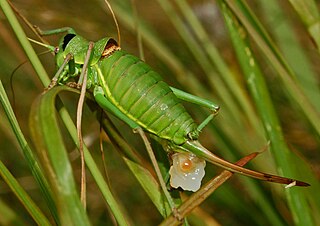
The Bradyporinae are a subfamily in the family Tettigoniidae, based on the type genus Bradyporus. First described as a family, "Bradyporidae", the first use as Bradyporinae was by Brunner von Wattenwyl in 1878.

Holochlora is a genus of bush-crickets in the subfamily Phaneropterinae. They occur in Africa and Asia.

Barbitistes constrictus is a species belonging to the family Tettigoniidae subfamily Phaneropterinae. It is found in Austria, Belarus, Central European Russia, Czech Republic, Estonia, Germany, Hungary, Kaliningrad Region, Latvia, Lithuania, North European Russia, Northwest European Russia, Poland, Romania and Slovakia. The species is found mainly in coniferous forests.
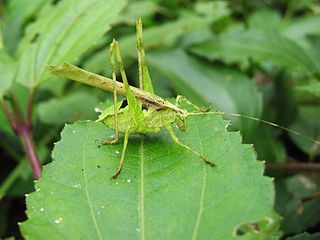
Insara, commonly known as western bush katydids, is a genus of katydids in the family Tettigoniidae.
Turpilia is a genus of phaneropterine katydids in the family Tettigoniidae. There are about nine described species in Turpilia.

Caedicia is a genus of bush crickets or katydids in the subfamily Phaneropterinae. Species can be found Australasia, with records from Vietnam, Papua New Guinea, and Australia.
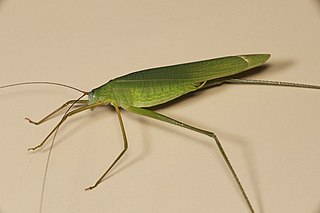
Elimaea is a large genus within Tettigoniidae, the bush cricket or katydid family. Species in this genus are found in India, southern China, Indo-China and Malesia.
Isopsera is an Asian genus of bush crickets in the subfamily Phaneropterinae. Species can be found in India, Indochina, Malesia and the Pacific Islands.
Orthelimaea is a genus of Asian bush crickets in the subfamily Phaneropterinae. Species in this genus are found in India, Indo-China, and Malesia.
Psyrana is a genus of Asian bush crickets of the tribe Holochlorini within the subfamily Phaneropterinae. They occur in Sri Lanka Indo-China, China, Korea, Japan, and Malesia to New Caledonia.

Orophus is a small genus of katydids native to Mexico, Central America, and South America.
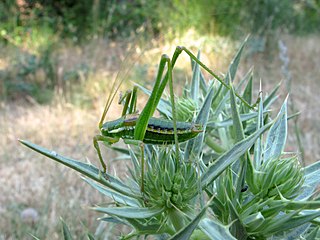
Odontura is a genus of bush crickets in the subfamily Phaneropterinae and typical of the tribe Odonturini. Species can be found in Africa and Europe.

Poecilimon is a genus of bush crickets in the subfamily Phaneropterinae and tribe Barbitistini. Species can be found in: central and Southeast Europe, the south of the European part of the former USSR, Asia Minor, Syria, Palestine, the Caucasus, Persia and extends in Central Asia to the Altai mountains.
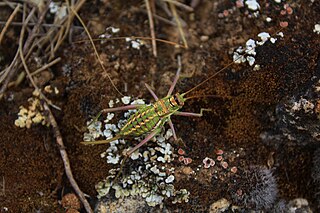
Parasteropleurus is a genus of bush crickets in the tribe Ephippigerini, erected by J. Barat in 2012 with insects that resembled Steropleurus. To date (2022) species have been recorded from the Iberian peninsula and North Africa.

Ancistrura is a monotypic genus of European bush crickets in the subfamily Phaneropterinae and tribe Barbitistini, erected by Boris Uvarov in 1921.















